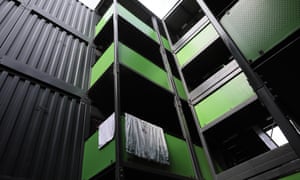‘They just dump you here’: the homeless families living in shipping containers
The tiny flats are cheap to build, but critics say their use shows ‘something has gone very wrong’

Eye-catchingly, Ikea-ishly modern with its brightly coloured exterior panelling glinting in the morning sun, Meath Court, a prefabricated apartment block in Ealing, west London, built from converted shipping containers, looks for all the world like a stylishly contemporary answer to the UK’s growing homelessness problem.
Cheap, quick to build – it went up in a miraculous 24 weeks on a plot of unused council-owned land – Meath Court hosts 60 households needing emergency housing. According to Ealing council the flats, which have been up and running for over 18 months, offer “a stable, private environment for homeless families with nowhere else to go”. There are others like it in Ealing, as well as Brighton and Bristol.
This week, however, container flats started to look a little less ingenious. The children’s commissioner for England, Anne Longfield, criticised them as unsuitable and unsafe. They were cramped, with nowhere to play or do homework, stiflingly hot in summer, and too cold in winter. That youngsters were growing up in them, she said, proved that “something has gone very wrong with our housing system”.
The housing charity Shelter weighed in, saying housing families in unsuitable converted shipping containers for months at a time was a “sad reflection” of the housing crisis. Poor temporary housing, said the Children’s Society, left youngsters feeling unsafe and anxious, and risked damaging their health and psychological wellbeing.

But what is the truth about container flats? Christine, 28, (not her real name) has lived in Meath Court with her young son for nearly a year. “When you first come here it is a bit daunting.” But her experience has not been traumatic. “I know people want to talk bad about it. I am not saying I want to live here forever because really I don’t. But for the circumstances and choice it is not bad.”
It is far from perfect, she admits. The lack of space is a problem. Getting around the kitchen and living room, no wider than the width of a lorry, is a constant, shuffling pirouette of tidying and avoiding. The tiny sofa is a little more than an arm’s length from the TV which sits awkwardly below eye-level on the floor (nothing can be bolted to the walls).
In the bedroom, her son’s raised bunk lies lengthways down one wall, covering the bottom half of Christine’s bed. Storage for clothes and toys, she says with a smile, is “not ideal”. But she is cheerily adamant it could be worse, and she is not worried about it restricting her active toddler son’s development “although it would be nice to have a big train track in the house like normal kids”.
Heat in the metal containers is a major issue, says Christine. When the temperature hit 34C a few weeks ago, she says they could hardly breathe in the upper floor apartment. She ended up sleeping with her son outside on the walkway. Once she left the window open to try to cool the apartment during the day, but an unexpected shower left puddles of water on her bed and floors.

The factory-converted containers are neat and modish, from the tiny kitchen unit to the wood-effect floors. The interior walls are encased in white plastic panels. The heater works – it never gets too cold in winter, Christine says. Even their critics admit container flats are superior to the often squalid B&B rooms that constitute much emergency homelessness accommodation.
But there are glaring problems, not least the absence of wifi in the building, which means children cannot go online for play or homework, and adds considerable hassle for adults whose interactions with the council landlord and the benefits system are increasingly online.
It is not that converted shipping containers are intrinsically unlivable. But they can struggle to cope with the reality of family homelessness. Another Meath Court tenant, Piotr, shows how almost every surface of his flat is piled high with clothes and toys. Residents have often been evicted from larger homes, and bring with them belongings from that more spacious former existence.
Although the flats were designed as “emergency accommodation”, Piotr has been in Meath Court for 18 months, with no end in sight. Christine was told she would be here for just two months. The scarcity of move-on family homes means there is a danger the flats become just another slightly inadequate form of temporary accommodation. “They just dump you and leave you here,” says Christine.

Built in partnership with a private developer, Meath Court cost around £35,000 per one-bed apartment – but they are not let at social housing rates. Christine’s rent – for now covered by housing benefit – is £270 a week, which is close to local private market rents. A homeless tenant with two young children at another Ealing container development was evicted by the council for falling behind on the rent.
It is easy to see why prefabricated housing looks increasingly attractive to local authorities on the frontline of England’s housing crisis. They are facing rising homelessness, together with a shrinking pool of affordable homes, and a £1bn bill for the 62,000 homeless families and 124,000 children living in all forms of temporary housing in England, an 80% rise since 2010.
Christine and her son are not untypical, forced to leave their private rented studio flat after it was declared a fire hazard and priced out of anywhere similar locally. They spent four months in a B&B (the legal limit for a B&B stay for homeless families is six weeks) before being given a flat in Meath Court. There are 9,000 people on Ealing’s social housing waiting list.
Ealing has three container developments with a fourth prefab (not built from containers) in the pipeline. It also plans 2,500 “genuinely affordable” permanent homes within three years. It blames right-to-buy council house sales and government welfare cuts for a growing housing crisis, leaving it “no choice but to use temporary accommodation to house the sheer volume of homeless households”.

A civil conversation…
… has never been more important in American public life. Guardian journalism, driven by fact-based reporting, offers an independent voice of reason at a time when the national conversation is divisive and embittered. At a time of acrimony, America is in need of public civility. For 200 years Guardian journalism has been committed to giving expression to hope, not hate, and choosing fairness over fear.
More people are reading and supporting The Guardian’s independent, investigative journalism than ever before. And unlike many news organisations, we have chosen an approach that allows us to keep our journalism accessible to all, regardless of where they live or what they can afford. But we need your ongoing support to keep working as we do.
The Guardian will engage with the most critical issues of our time – from the escalating climate catastrophe to widespread inequality to the influence of big tech on our lives. At a time when factual information is a necessity, we believe that each of us, around the world, deserves access to accurate reporting with integrity at its heart.
Our editorial independence means we set our own agenda and voice our own opinions. Guardian journalism is free from commercial and political bias and not influenced by billionaire owners or shareholders. This means we can give a voice to those less heard, explore where others turn away, and rigorously challenge those in power.
We need your support to keep delivering quality journalism, to maintain our openness and to protect our precious independence. Every reader contribution, big or small, is so valuable. Support The Guardian from as little as $1 – and it only takes a minute. Thank you.









Follow Us!